Medication Error Reduction in Acute Hospital Settings: Lewin's Model
VerifiedAdded on 2022/10/11
|9
|2790
|19
Report
AI Summary
This report examines the critical issue of medication errors in acute hospital settings and proposes the implementation of bar-coded medication administration as a quality improvement strategy. The introduction highlights the prevalence and consequences of medication errors, citing relevant literature to emphasize the need for change. The report then provides a detailed overview of Lewin's Change Model, including the unfreezing, changing, and refreezing stages, and explains how this model can be applied to successfully implement bar-coded medication administration. The analysis includes a discussion of potential influences on the implementation of change, such as staff resistance, organizational culture, and the need for effective planning and communication. The conclusion summarizes the key findings and reinforces the importance of adopting bar-coded medication administration to enhance patient safety and improve healthcare quality. The report is supported by numerous references from the last 5-8 years, adhering to APA 6th edition guidelines.
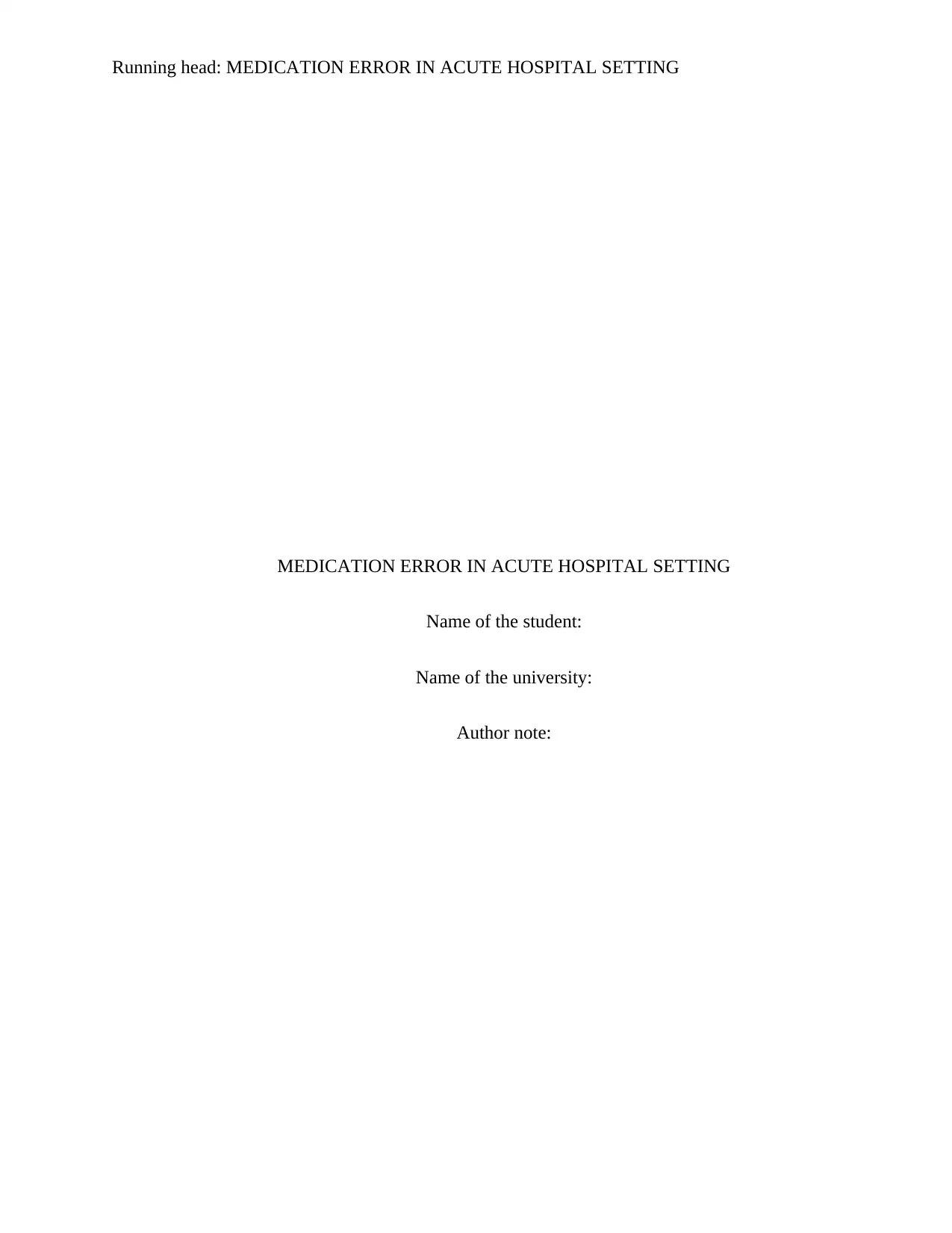
Running head: MEDICATION ERROR IN ACUTE HOSPITAL SETTING
MEDICATION ERROR IN ACUTE HOSPITAL SETTING
Name of the student:
Name of the university:
Author note:
MEDICATION ERROR IN ACUTE HOSPITAL SETTING
Name of the student:
Name of the university:
Author note:
Paraphrase This Document
Need a fresh take? Get an instant paraphrase of this document with our AI Paraphraser
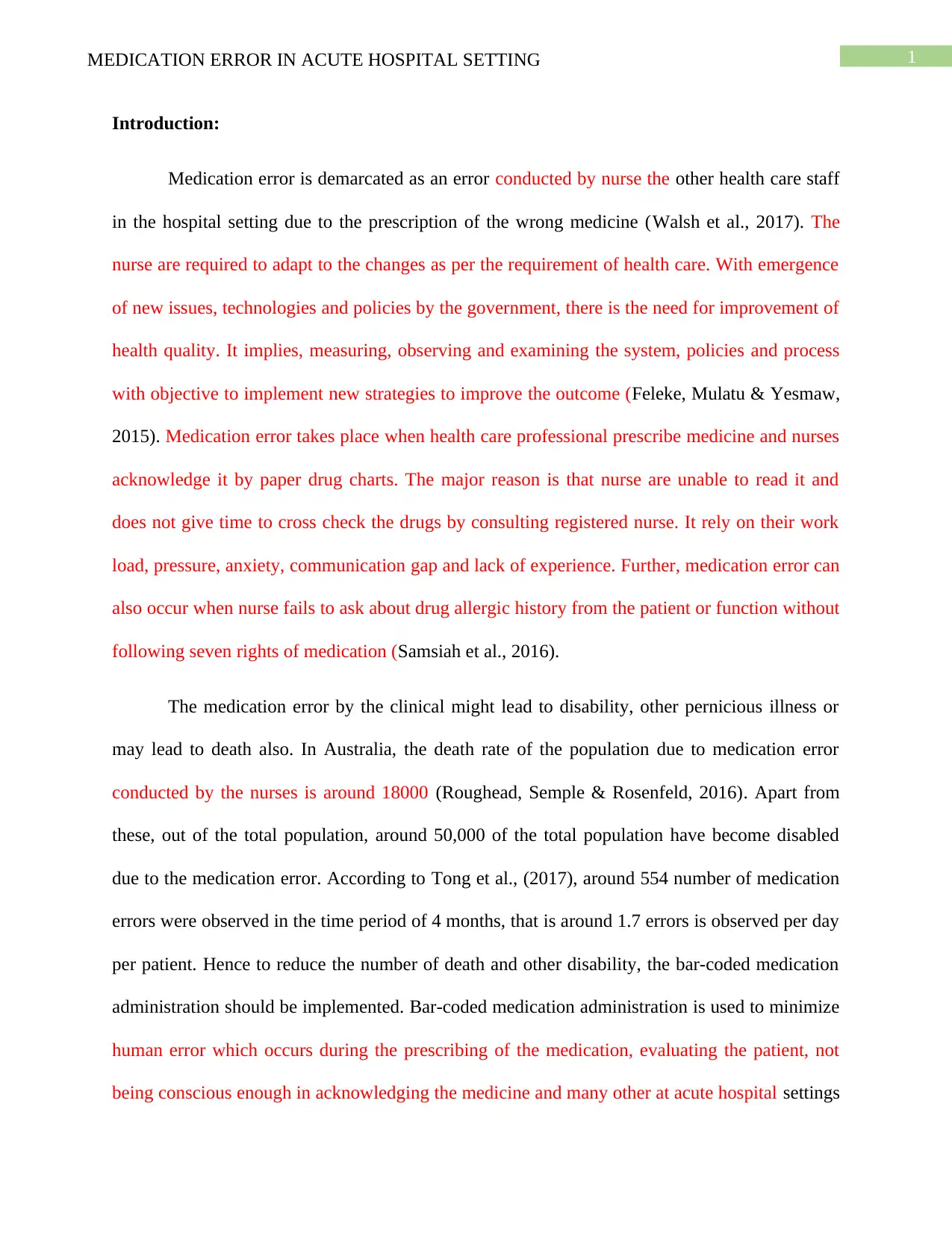
1MEDICATION ERROR IN ACUTE HOSPITAL SETTING
Introduction:
Medication error is demarcated as an error conducted by nurse the other health care staff
in the hospital setting due to the prescription of the wrong medicine (Walsh et al., 2017). The
nurse are required to adapt to the changes as per the requirement of health care. With emergence
of new issues, technologies and policies by the government, there is the need for improvement of
health quality. It implies, measuring, observing and examining the system, policies and process
with objective to implement new strategies to improve the outcome (Feleke, Mulatu & Yesmaw,
2015). Medication error takes place when health care professional prescribe medicine and nurses
acknowledge it by paper drug charts. The major reason is that nurse are unable to read it and
does not give time to cross check the drugs by consulting registered nurse. It rely on their work
load, pressure, anxiety, communication gap and lack of experience. Further, medication error can
also occur when nurse fails to ask about drug allergic history from the patient or function without
following seven rights of medication (Samsiah et al., 2016).
The medication error by the clinical might lead to disability, other pernicious illness or
may lead to death also. In Australia, the death rate of the population due to medication error
conducted by the nurses is around 18000 (Roughead, Semple & Rosenfeld, 2016). Apart from
these, out of the total population, around 50,000 of the total population have become disabled
due to the medication error. According to Tong et al., (2017), around 554 number of medication
errors were observed in the time period of 4 months, that is around 1.7 errors is observed per day
per patient. Hence to reduce the number of death and other disability, the bar-coded medication
administration should be implemented. Bar-coded medication administration is used to minimize
human error which occurs during the prescribing of the medication, evaluating the patient, not
being conscious enough in acknowledging the medicine and many other at acute hospital settings
Introduction:
Medication error is demarcated as an error conducted by nurse the other health care staff
in the hospital setting due to the prescription of the wrong medicine (Walsh et al., 2017). The
nurse are required to adapt to the changes as per the requirement of health care. With emergence
of new issues, technologies and policies by the government, there is the need for improvement of
health quality. It implies, measuring, observing and examining the system, policies and process
with objective to implement new strategies to improve the outcome (Feleke, Mulatu & Yesmaw,
2015). Medication error takes place when health care professional prescribe medicine and nurses
acknowledge it by paper drug charts. The major reason is that nurse are unable to read it and
does not give time to cross check the drugs by consulting registered nurse. It rely on their work
load, pressure, anxiety, communication gap and lack of experience. Further, medication error can
also occur when nurse fails to ask about drug allergic history from the patient or function without
following seven rights of medication (Samsiah et al., 2016).
The medication error by the clinical might lead to disability, other pernicious illness or
may lead to death also. In Australia, the death rate of the population due to medication error
conducted by the nurses is around 18000 (Roughead, Semple & Rosenfeld, 2016). Apart from
these, out of the total population, around 50,000 of the total population have become disabled
due to the medication error. According to Tong et al., (2017), around 554 number of medication
errors were observed in the time period of 4 months, that is around 1.7 errors is observed per day
per patient. Hence to reduce the number of death and other disability, the bar-coded medication
administration should be implemented. Bar-coded medication administration is used to minimize
human error which occurs during the prescribing of the medication, evaluating the patient, not
being conscious enough in acknowledging the medicine and many other at acute hospital settings
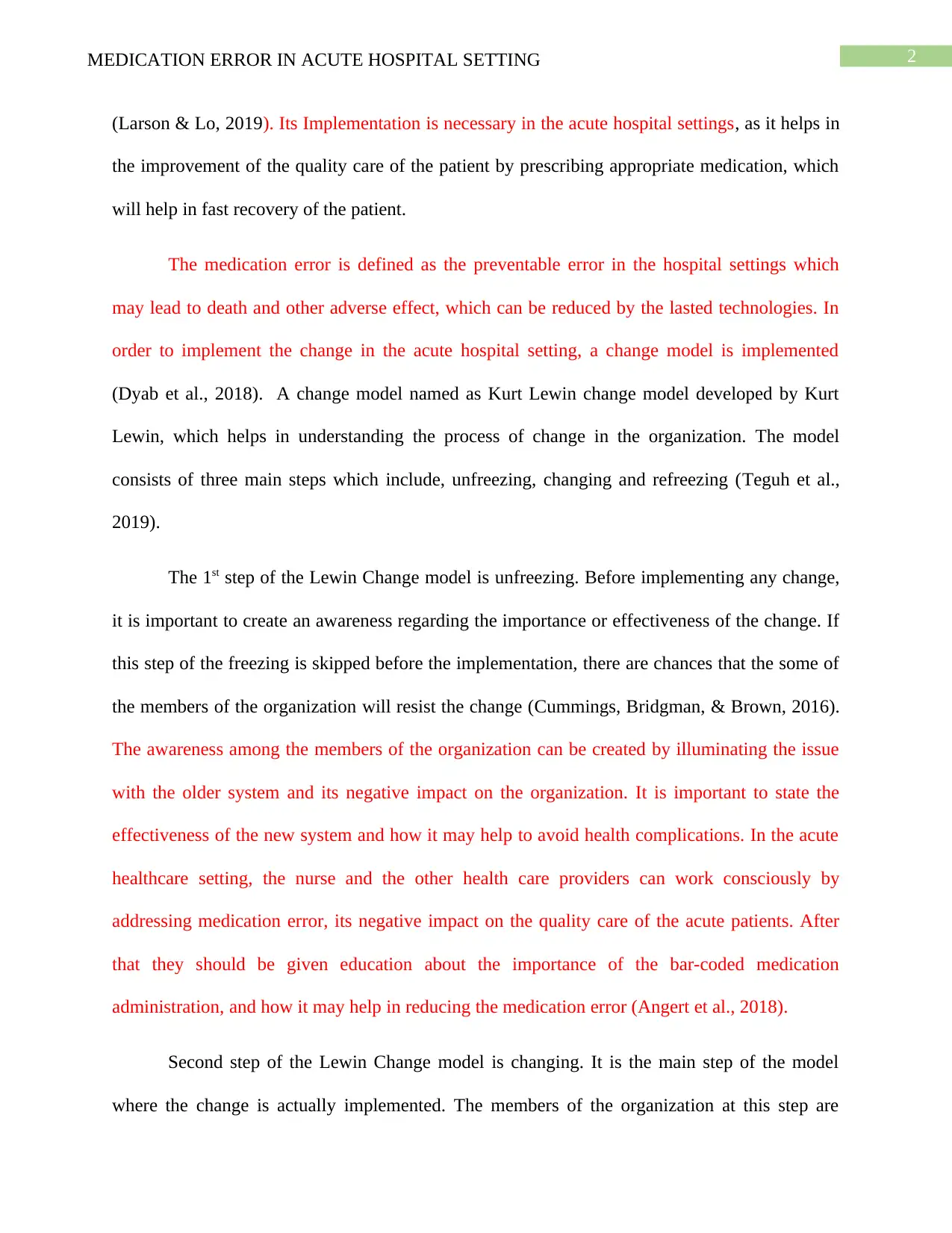
2MEDICATION ERROR IN ACUTE HOSPITAL SETTING
(Larson & Lo, 2019). Its Implementation is necessary in the acute hospital settings, as it helps in
the improvement of the quality care of the patient by prescribing appropriate medication, which
will help in fast recovery of the patient.
The medication error is defined as the preventable error in the hospital settings which
may lead to death and other adverse effect, which can be reduced by the lasted technologies. In
order to implement the change in the acute hospital setting, a change model is implemented
(Dyab et al., 2018). A change model named as Kurt Lewin change model developed by Kurt
Lewin, which helps in understanding the process of change in the organization. The model
consists of three main steps which include, unfreezing, changing and refreezing (Teguh et al.,
2019).
The 1st step of the Lewin Change model is unfreezing. Before implementing any change,
it is important to create an awareness regarding the importance or effectiveness of the change. If
this step of the freezing is skipped before the implementation, there are chances that the some of
the members of the organization will resist the change (Cummings, Bridgman, & Brown, 2016).
The awareness among the members of the organization can be created by illuminating the issue
with the older system and its negative impact on the organization. It is important to state the
effectiveness of the new system and how it may help to avoid health complications. In the acute
healthcare setting, the nurse and the other health care providers can work consciously by
addressing medication error, its negative impact on the quality care of the acute patients. After
that they should be given education about the importance of the bar-coded medication
administration, and how it may help in reducing the medication error (Angert et al., 2018).
Second step of the Lewin Change model is changing. It is the main step of the model
where the change is actually implemented. The members of the organization at this step are
(Larson & Lo, 2019). Its Implementation is necessary in the acute hospital settings, as it helps in
the improvement of the quality care of the patient by prescribing appropriate medication, which
will help in fast recovery of the patient.
The medication error is defined as the preventable error in the hospital settings which
may lead to death and other adverse effect, which can be reduced by the lasted technologies. In
order to implement the change in the acute hospital setting, a change model is implemented
(Dyab et al., 2018). A change model named as Kurt Lewin change model developed by Kurt
Lewin, which helps in understanding the process of change in the organization. The model
consists of three main steps which include, unfreezing, changing and refreezing (Teguh et al.,
2019).
The 1st step of the Lewin Change model is unfreezing. Before implementing any change,
it is important to create an awareness regarding the importance or effectiveness of the change. If
this step of the freezing is skipped before the implementation, there are chances that the some of
the members of the organization will resist the change (Cummings, Bridgman, & Brown, 2016).
The awareness among the members of the organization can be created by illuminating the issue
with the older system and its negative impact on the organization. It is important to state the
effectiveness of the new system and how it may help to avoid health complications. In the acute
healthcare setting, the nurse and the other health care providers can work consciously by
addressing medication error, its negative impact on the quality care of the acute patients. After
that they should be given education about the importance of the bar-coded medication
administration, and how it may help in reducing the medication error (Angert et al., 2018).
Second step of the Lewin Change model is changing. It is the main step of the model
where the change is actually implemented. The members of the organization at this step are
⊘ This is a preview!⊘
Do you want full access?
Subscribe today to unlock all pages.

Trusted by 1+ million students worldwide
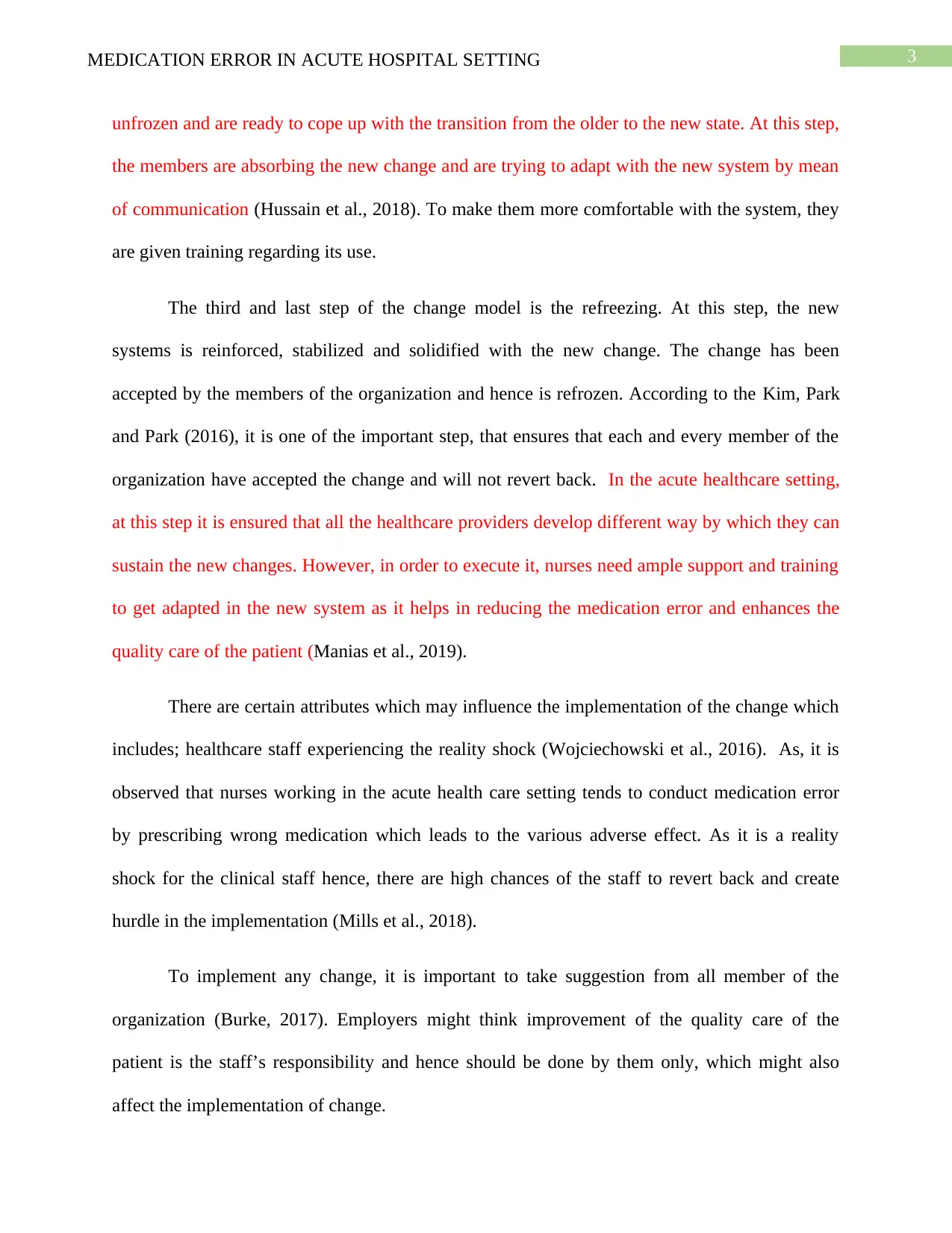
3MEDICATION ERROR IN ACUTE HOSPITAL SETTING
unfrozen and are ready to cope up with the transition from the older to the new state. At this step,
the members are absorbing the new change and are trying to adapt with the new system by mean
of communication (Hussain et al., 2018). To make them more comfortable with the system, they
are given training regarding its use.
The third and last step of the change model is the refreezing. At this step, the new
systems is reinforced, stabilized and solidified with the new change. The change has been
accepted by the members of the organization and hence is refrozen. According to the Kim, Park
and Park (2016), it is one of the important step, that ensures that each and every member of the
organization have accepted the change and will not revert back. In the acute healthcare setting,
at this step it is ensured that all the healthcare providers develop different way by which they can
sustain the new changes. However, in order to execute it, nurses need ample support and training
to get adapted in the new system as it helps in reducing the medication error and enhances the
quality care of the patient (Manias et al., 2019).
There are certain attributes which may influence the implementation of the change which
includes; healthcare staff experiencing the reality shock (Wojciechowski et al., 2016). As, it is
observed that nurses working in the acute health care setting tends to conduct medication error
by prescribing wrong medication which leads to the various adverse effect. As it is a reality
shock for the clinical staff hence, there are high chances of the staff to revert back and create
hurdle in the implementation (Mills et al., 2018).
To implement any change, it is important to take suggestion from all member of the
organization (Burke, 2017). Employers might think improvement of the quality care of the
patient is the staff’s responsibility and hence should be done by them only, which might also
affect the implementation of change.
unfrozen and are ready to cope up with the transition from the older to the new state. At this step,
the members are absorbing the new change and are trying to adapt with the new system by mean
of communication (Hussain et al., 2018). To make them more comfortable with the system, they
are given training regarding its use.
The third and last step of the change model is the refreezing. At this step, the new
systems is reinforced, stabilized and solidified with the new change. The change has been
accepted by the members of the organization and hence is refrozen. According to the Kim, Park
and Park (2016), it is one of the important step, that ensures that each and every member of the
organization have accepted the change and will not revert back. In the acute healthcare setting,
at this step it is ensured that all the healthcare providers develop different way by which they can
sustain the new changes. However, in order to execute it, nurses need ample support and training
to get adapted in the new system as it helps in reducing the medication error and enhances the
quality care of the patient (Manias et al., 2019).
There are certain attributes which may influence the implementation of the change which
includes; healthcare staff experiencing the reality shock (Wojciechowski et al., 2016). As, it is
observed that nurses working in the acute health care setting tends to conduct medication error
by prescribing wrong medication which leads to the various adverse effect. As it is a reality
shock for the clinical staff hence, there are high chances of the staff to revert back and create
hurdle in the implementation (Mills et al., 2018).
To implement any change, it is important to take suggestion from all member of the
organization (Burke, 2017). Employers might think improvement of the quality care of the
patient is the staff’s responsibility and hence should be done by them only, which might also
affect the implementation of change.
Paraphrase This Document
Need a fresh take? Get an instant paraphrase of this document with our AI Paraphraser
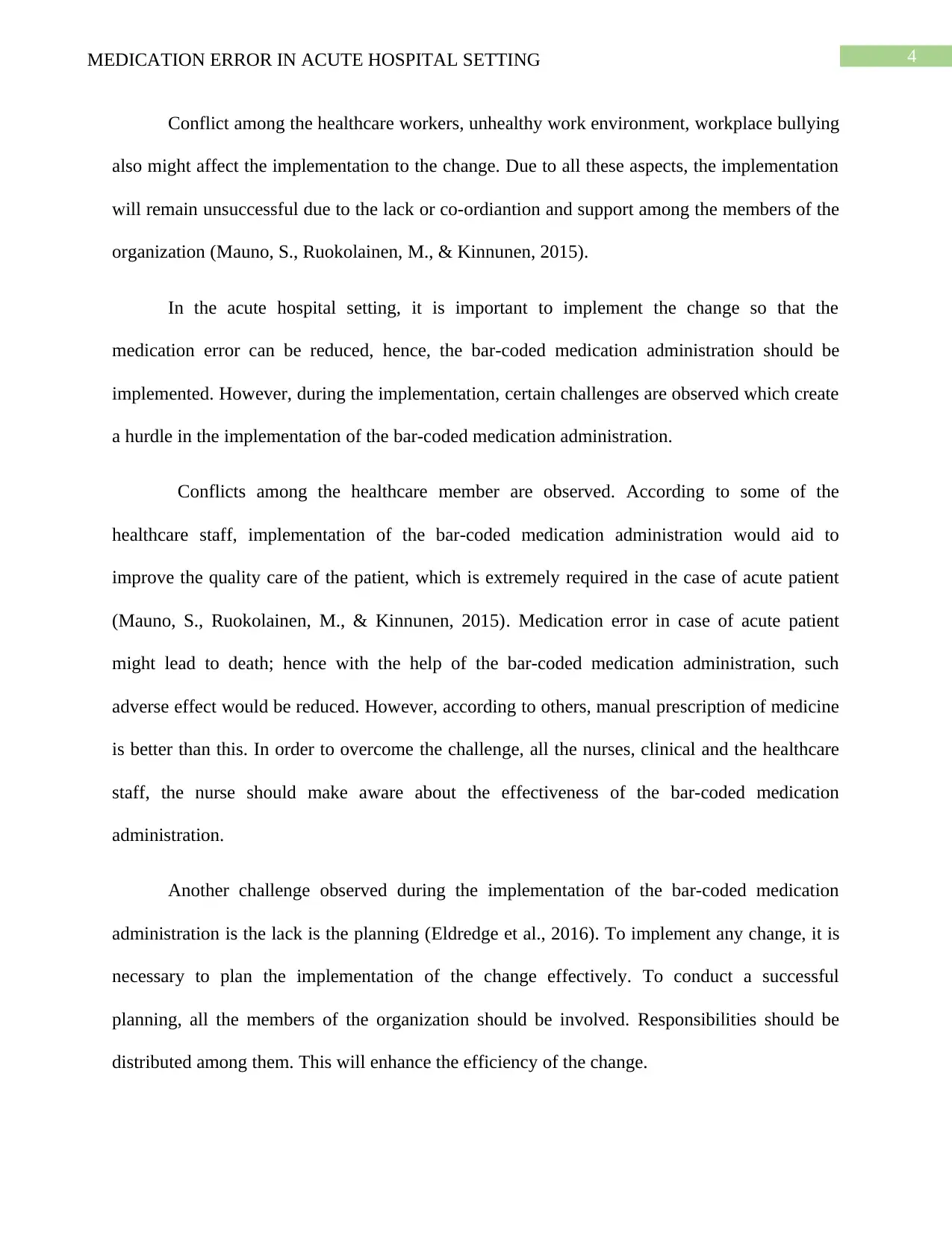
4MEDICATION ERROR IN ACUTE HOSPITAL SETTING
Conflict among the healthcare workers, unhealthy work environment, workplace bullying
also might affect the implementation to the change. Due to all these aspects, the implementation
will remain unsuccessful due to the lack or co-ordiantion and support among the members of the
organization (Mauno, S., Ruokolainen, M., & Kinnunen, 2015).
In the acute hospital setting, it is important to implement the change so that the
medication error can be reduced, hence, the bar-coded medication administration should be
implemented. However, during the implementation, certain challenges are observed which create
a hurdle in the implementation of the bar-coded medication administration.
Conflicts among the healthcare member are observed. According to some of the
healthcare staff, implementation of the bar-coded medication administration would aid to
improve the quality care of the patient, which is extremely required in the case of acute patient
(Mauno, S., Ruokolainen, M., & Kinnunen, 2015). Medication error in case of acute patient
might lead to death; hence with the help of the bar-coded medication administration, such
adverse effect would be reduced. However, according to others, manual prescription of medicine
is better than this. In order to overcome the challenge, all the nurses, clinical and the healthcare
staff, the nurse should make aware about the effectiveness of the bar-coded medication
administration.
Another challenge observed during the implementation of the bar-coded medication
administration is the lack is the planning (Eldredge et al., 2016). To implement any change, it is
necessary to plan the implementation of the change effectively. To conduct a successful
planning, all the members of the organization should be involved. Responsibilities should be
distributed among them. This will enhance the efficiency of the change.
Conflict among the healthcare workers, unhealthy work environment, workplace bullying
also might affect the implementation to the change. Due to all these aspects, the implementation
will remain unsuccessful due to the lack or co-ordiantion and support among the members of the
organization (Mauno, S., Ruokolainen, M., & Kinnunen, 2015).
In the acute hospital setting, it is important to implement the change so that the
medication error can be reduced, hence, the bar-coded medication administration should be
implemented. However, during the implementation, certain challenges are observed which create
a hurdle in the implementation of the bar-coded medication administration.
Conflicts among the healthcare member are observed. According to some of the
healthcare staff, implementation of the bar-coded medication administration would aid to
improve the quality care of the patient, which is extremely required in the case of acute patient
(Mauno, S., Ruokolainen, M., & Kinnunen, 2015). Medication error in case of acute patient
might lead to death; hence with the help of the bar-coded medication administration, such
adverse effect would be reduced. However, according to others, manual prescription of medicine
is better than this. In order to overcome the challenge, all the nurses, clinical and the healthcare
staff, the nurse should make aware about the effectiveness of the bar-coded medication
administration.
Another challenge observed during the implementation of the bar-coded medication
administration is the lack is the planning (Eldredge et al., 2016). To implement any change, it is
necessary to plan the implementation of the change effectively. To conduct a successful
planning, all the members of the organization should be involved. Responsibilities should be
distributed among them. This will enhance the efficiency of the change.
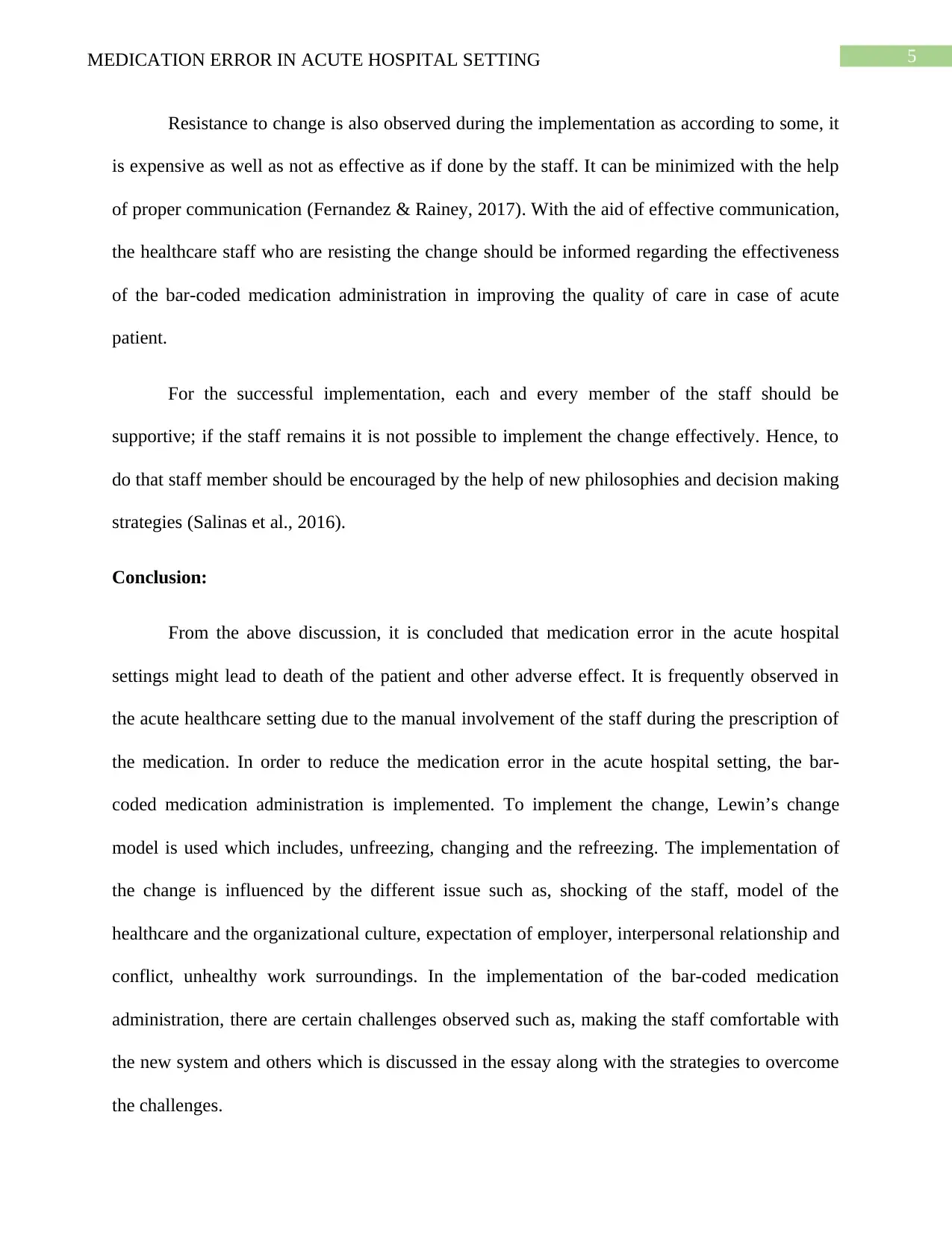
5MEDICATION ERROR IN ACUTE HOSPITAL SETTING
Resistance to change is also observed during the implementation as according to some, it
is expensive as well as not as effective as if done by the staff. It can be minimized with the help
of proper communication (Fernandez & Rainey, 2017). With the aid of effective communication,
the healthcare staff who are resisting the change should be informed regarding the effectiveness
of the bar-coded medication administration in improving the quality of care in case of acute
patient.
For the successful implementation, each and every member of the staff should be
supportive; if the staff remains it is not possible to implement the change effectively. Hence, to
do that staff member should be encouraged by the help of new philosophies and decision making
strategies (Salinas et al., 2016).
Conclusion:
From the above discussion, it is concluded that medication error in the acute hospital
settings might lead to death of the patient and other adverse effect. It is frequently observed in
the acute healthcare setting due to the manual involvement of the staff during the prescription of
the medication. In order to reduce the medication error in the acute hospital setting, the bar-
coded medication administration is implemented. To implement the change, Lewin’s change
model is used which includes, unfreezing, changing and the refreezing. The implementation of
the change is influenced by the different issue such as, shocking of the staff, model of the
healthcare and the organizational culture, expectation of employer, interpersonal relationship and
conflict, unhealthy work surroundings. In the implementation of the bar-coded medication
administration, there are certain challenges observed such as, making the staff comfortable with
the new system and others which is discussed in the essay along with the strategies to overcome
the challenges.
Resistance to change is also observed during the implementation as according to some, it
is expensive as well as not as effective as if done by the staff. It can be minimized with the help
of proper communication (Fernandez & Rainey, 2017). With the aid of effective communication,
the healthcare staff who are resisting the change should be informed regarding the effectiveness
of the bar-coded medication administration in improving the quality of care in case of acute
patient.
For the successful implementation, each and every member of the staff should be
supportive; if the staff remains it is not possible to implement the change effectively. Hence, to
do that staff member should be encouraged by the help of new philosophies and decision making
strategies (Salinas et al., 2016).
Conclusion:
From the above discussion, it is concluded that medication error in the acute hospital
settings might lead to death of the patient and other adverse effect. It is frequently observed in
the acute healthcare setting due to the manual involvement of the staff during the prescription of
the medication. In order to reduce the medication error in the acute hospital setting, the bar-
coded medication administration is implemented. To implement the change, Lewin’s change
model is used which includes, unfreezing, changing and the refreezing. The implementation of
the change is influenced by the different issue such as, shocking of the staff, model of the
healthcare and the organizational culture, expectation of employer, interpersonal relationship and
conflict, unhealthy work surroundings. In the implementation of the bar-coded medication
administration, there are certain challenges observed such as, making the staff comfortable with
the new system and others which is discussed in the essay along with the strategies to overcome
the challenges.
⊘ This is a preview!⊘
Do you want full access?
Subscribe today to unlock all pages.

Trusted by 1+ million students worldwide
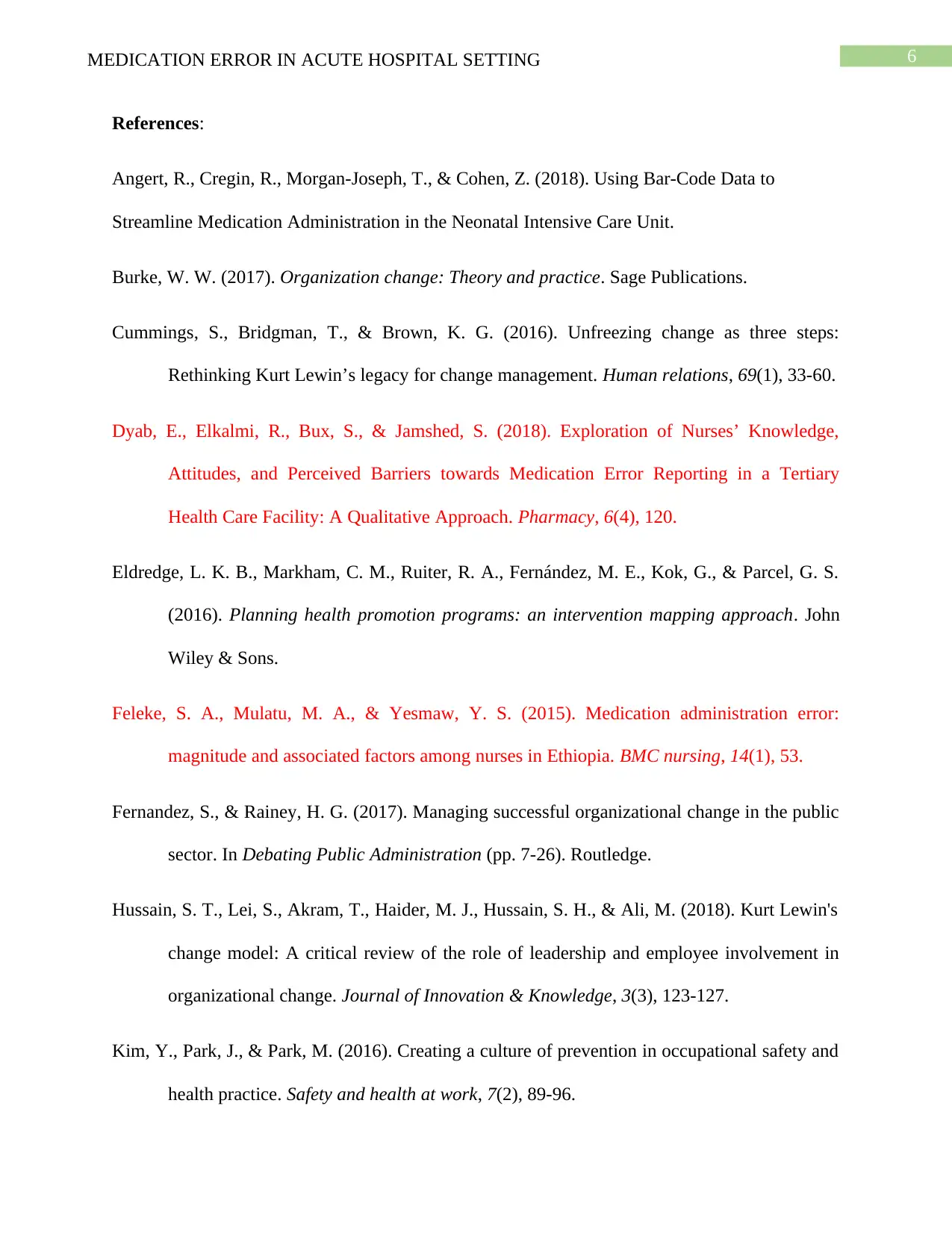
6MEDICATION ERROR IN ACUTE HOSPITAL SETTING
References:
Angert, R., Cregin, R., Morgan-Joseph, T., & Cohen, Z. (2018). Using Bar-Code Data to
Streamline Medication Administration in the Neonatal Intensive Care Unit.
Burke, W. W. (2017). Organization change: Theory and practice. Sage Publications.
Cummings, S., Bridgman, T., & Brown, K. G. (2016). Unfreezing change as three steps:
Rethinking Kurt Lewin’s legacy for change management. Human relations, 69(1), 33-60.
Dyab, E., Elkalmi, R., Bux, S., & Jamshed, S. (2018). Exploration of Nurses’ Knowledge,
Attitudes, and Perceived Barriers towards Medication Error Reporting in a Tertiary
Health Care Facility: A Qualitative Approach. Pharmacy, 6(4), 120.
Eldredge, L. K. B., Markham, C. M., Ruiter, R. A., Fernández, M. E., Kok, G., & Parcel, G. S.
(2016). Planning health promotion programs: an intervention mapping approach. John
Wiley & Sons.
Feleke, S. A., Mulatu, M. A., & Yesmaw, Y. S. (2015). Medication administration error:
magnitude and associated factors among nurses in Ethiopia. BMC nursing, 14(1), 53.
Fernandez, S., & Rainey, H. G. (2017). Managing successful organizational change in the public
sector. In Debating Public Administration (pp. 7-26). Routledge.
Hussain, S. T., Lei, S., Akram, T., Haider, M. J., Hussain, S. H., & Ali, M. (2018). Kurt Lewin's
change model: A critical review of the role of leadership and employee involvement in
organizational change. Journal of Innovation & Knowledge, 3(3), 123-127.
Kim, Y., Park, J., & Park, M. (2016). Creating a culture of prevention in occupational safety and
health practice. Safety and health at work, 7(2), 89-96.
References:
Angert, R., Cregin, R., Morgan-Joseph, T., & Cohen, Z. (2018). Using Bar-Code Data to
Streamline Medication Administration in the Neonatal Intensive Care Unit.
Burke, W. W. (2017). Organization change: Theory and practice. Sage Publications.
Cummings, S., Bridgman, T., & Brown, K. G. (2016). Unfreezing change as three steps:
Rethinking Kurt Lewin’s legacy for change management. Human relations, 69(1), 33-60.
Dyab, E., Elkalmi, R., Bux, S., & Jamshed, S. (2018). Exploration of Nurses’ Knowledge,
Attitudes, and Perceived Barriers towards Medication Error Reporting in a Tertiary
Health Care Facility: A Qualitative Approach. Pharmacy, 6(4), 120.
Eldredge, L. K. B., Markham, C. M., Ruiter, R. A., Fernández, M. E., Kok, G., & Parcel, G. S.
(2016). Planning health promotion programs: an intervention mapping approach. John
Wiley & Sons.
Feleke, S. A., Mulatu, M. A., & Yesmaw, Y. S. (2015). Medication administration error:
magnitude and associated factors among nurses in Ethiopia. BMC nursing, 14(1), 53.
Fernandez, S., & Rainey, H. G. (2017). Managing successful organizational change in the public
sector. In Debating Public Administration (pp. 7-26). Routledge.
Hussain, S. T., Lei, S., Akram, T., Haider, M. J., Hussain, S. H., & Ali, M. (2018). Kurt Lewin's
change model: A critical review of the role of leadership and employee involvement in
organizational change. Journal of Innovation & Knowledge, 3(3), 123-127.
Kim, Y., Park, J., & Park, M. (2016). Creating a culture of prevention in occupational safety and
health practice. Safety and health at work, 7(2), 89-96.
Paraphrase This Document
Need a fresh take? Get an instant paraphrase of this document with our AI Paraphraser
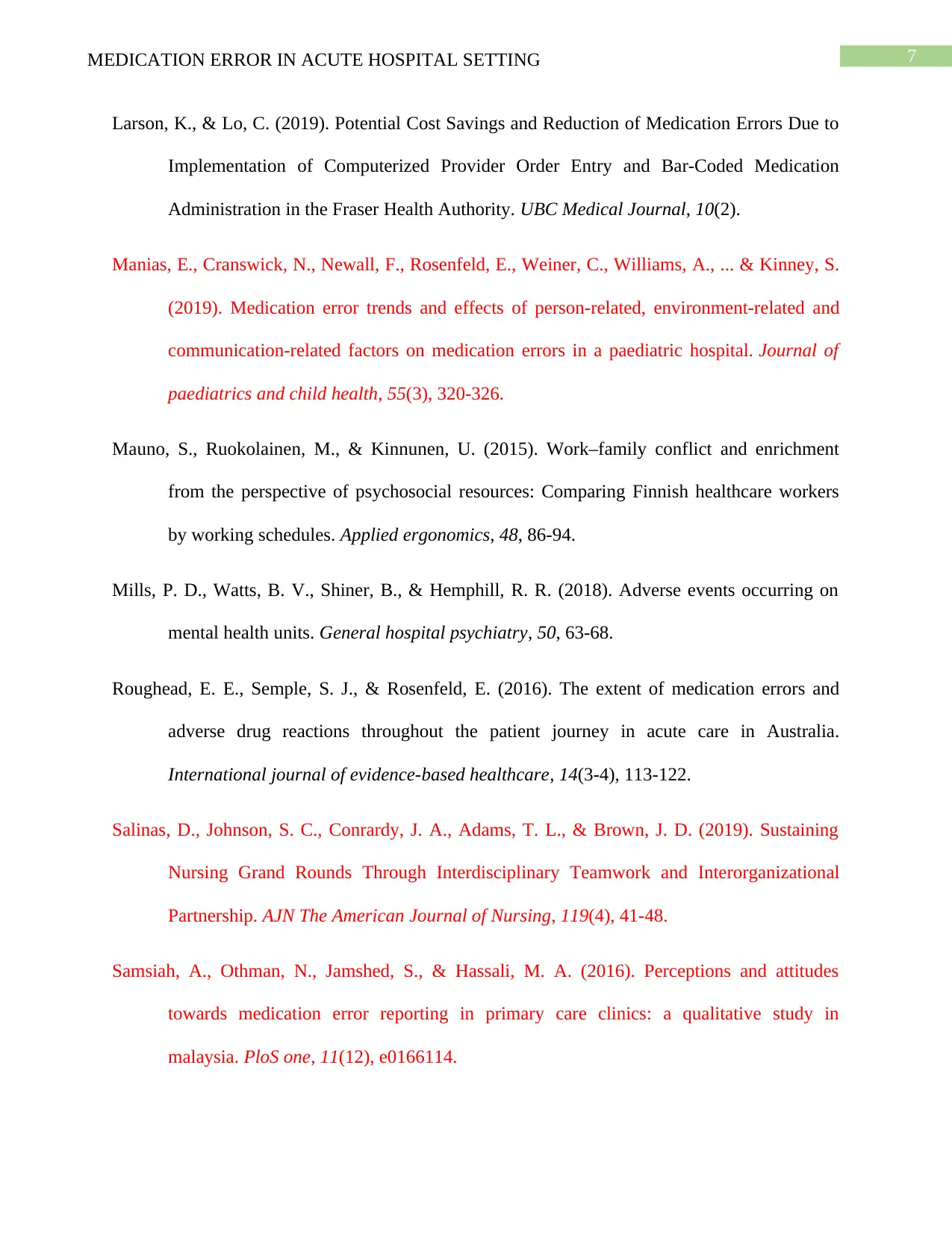
7MEDICATION ERROR IN ACUTE HOSPITAL SETTING
Larson, K., & Lo, C. (2019). Potential Cost Savings and Reduction of Medication Errors Due to
Implementation of Computerized Provider Order Entry and Bar-Coded Medication
Administration in the Fraser Health Authority. UBC Medical Journal, 10(2).
Manias, E., Cranswick, N., Newall, F., Rosenfeld, E., Weiner, C., Williams, A., ... & Kinney, S.
(2019). Medication error trends and effects of person‐related, environment‐related and
communication‐related factors on medication errors in a paediatric hospital. Journal of
paediatrics and child health, 55(3), 320-326.
Mauno, S., Ruokolainen, M., & Kinnunen, U. (2015). Work–family conflict and enrichment
from the perspective of psychosocial resources: Comparing Finnish healthcare workers
by working schedules. Applied ergonomics, 48, 86-94.
Mills, P. D., Watts, B. V., Shiner, B., & Hemphill, R. R. (2018). Adverse events occurring on
mental health units. General hospital psychiatry, 50, 63-68.
Roughead, E. E., Semple, S. J., & Rosenfeld, E. (2016). The extent of medication errors and
adverse drug reactions throughout the patient journey in acute care in Australia.
International journal of evidence-based healthcare, 14(3-4), 113-122.
Salinas, D., Johnson, S. C., Conrardy, J. A., Adams, T. L., & Brown, J. D. (2019). Sustaining
Nursing Grand Rounds Through Interdisciplinary Teamwork and Interorganizational
Partnership. AJN The American Journal of Nursing, 119(4), 41-48.
Samsiah, A., Othman, N., Jamshed, S., & Hassali, M. A. (2016). Perceptions and attitudes
towards medication error reporting in primary care clinics: a qualitative study in
malaysia. PloS one, 11(12), e0166114.
Larson, K., & Lo, C. (2019). Potential Cost Savings and Reduction of Medication Errors Due to
Implementation of Computerized Provider Order Entry and Bar-Coded Medication
Administration in the Fraser Health Authority. UBC Medical Journal, 10(2).
Manias, E., Cranswick, N., Newall, F., Rosenfeld, E., Weiner, C., Williams, A., ... & Kinney, S.
(2019). Medication error trends and effects of person‐related, environment‐related and
communication‐related factors on medication errors in a paediatric hospital. Journal of
paediatrics and child health, 55(3), 320-326.
Mauno, S., Ruokolainen, M., & Kinnunen, U. (2015). Work–family conflict and enrichment
from the perspective of psychosocial resources: Comparing Finnish healthcare workers
by working schedules. Applied ergonomics, 48, 86-94.
Mills, P. D., Watts, B. V., Shiner, B., & Hemphill, R. R. (2018). Adverse events occurring on
mental health units. General hospital psychiatry, 50, 63-68.
Roughead, E. E., Semple, S. J., & Rosenfeld, E. (2016). The extent of medication errors and
adverse drug reactions throughout the patient journey in acute care in Australia.
International journal of evidence-based healthcare, 14(3-4), 113-122.
Salinas, D., Johnson, S. C., Conrardy, J. A., Adams, T. L., & Brown, J. D. (2019). Sustaining
Nursing Grand Rounds Through Interdisciplinary Teamwork and Interorganizational
Partnership. AJN The American Journal of Nursing, 119(4), 41-48.
Samsiah, A., Othman, N., Jamshed, S., & Hassali, M. A. (2016). Perceptions and attitudes
towards medication error reporting in primary care clinics: a qualitative study in
malaysia. PloS one, 11(12), e0166114.
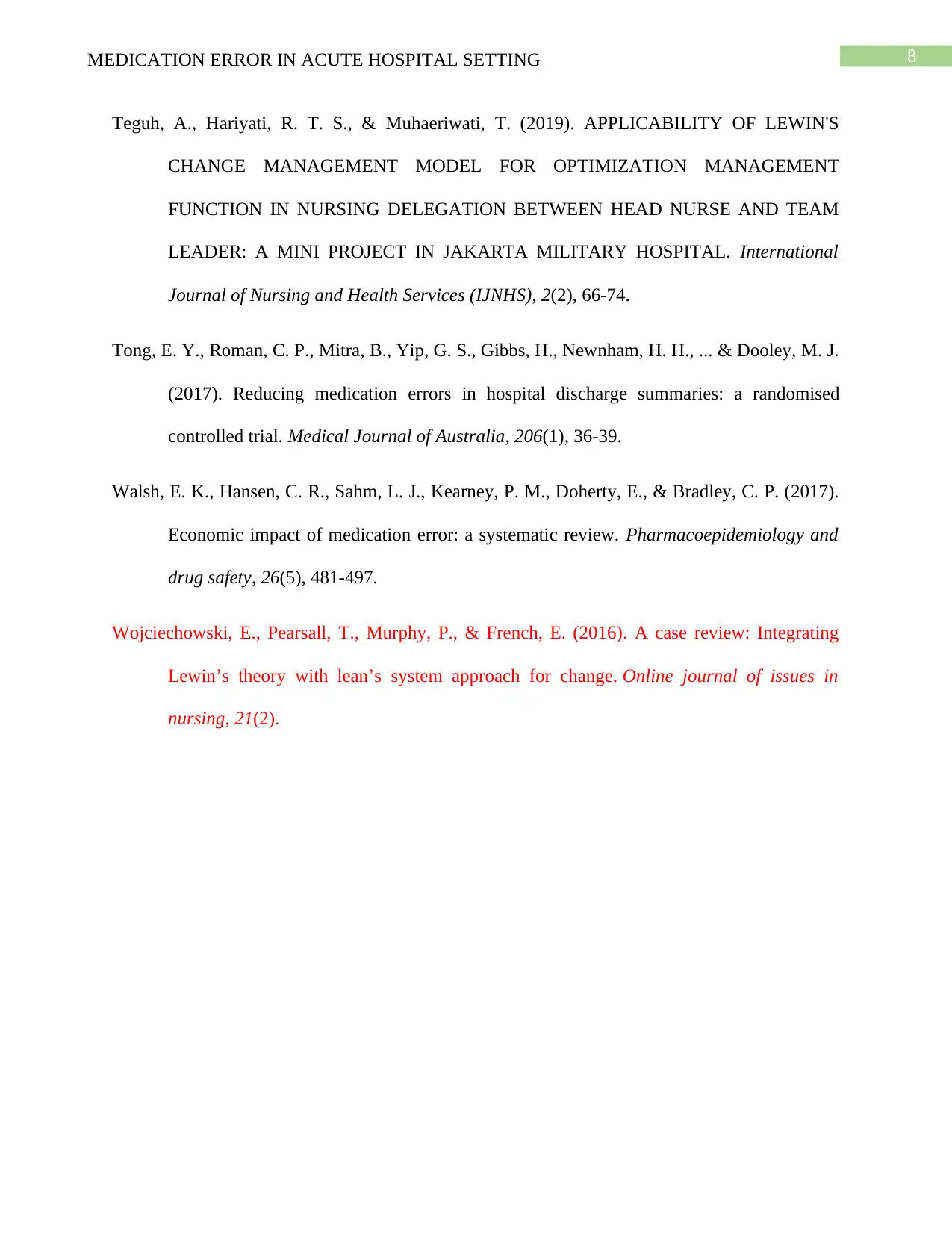
8MEDICATION ERROR IN ACUTE HOSPITAL SETTING
Teguh, A., Hariyati, R. T. S., & Muhaeriwati, T. (2019). APPLICABILITY OF LEWIN'S
CHANGE MANAGEMENT MODEL FOR OPTIMIZATION MANAGEMENT
FUNCTION IN NURSING DELEGATION BETWEEN HEAD NURSE AND TEAM
LEADER: A MINI PROJECT IN JAKARTA MILITARY HOSPITAL. International
Journal of Nursing and Health Services (IJNHS), 2(2), 66-74.
Tong, E. Y., Roman, C. P., Mitra, B., Yip, G. S., Gibbs, H., Newnham, H. H., ... & Dooley, M. J.
(2017). Reducing medication errors in hospital discharge summaries: a randomised
controlled trial. Medical Journal of Australia, 206(1), 36-39.
Walsh, E. K., Hansen, C. R., Sahm, L. J., Kearney, P. M., Doherty, E., & Bradley, C. P. (2017).
Economic impact of medication error: a systematic review. Pharmacoepidemiology and
drug safety, 26(5), 481-497.
Wojciechowski, E., Pearsall, T., Murphy, P., & French, E. (2016). A case review: Integrating
Lewin’s theory with lean’s system approach for change. Online journal of issues in
nursing, 21(2).
Teguh, A., Hariyati, R. T. S., & Muhaeriwati, T. (2019). APPLICABILITY OF LEWIN'S
CHANGE MANAGEMENT MODEL FOR OPTIMIZATION MANAGEMENT
FUNCTION IN NURSING DELEGATION BETWEEN HEAD NURSE AND TEAM
LEADER: A MINI PROJECT IN JAKARTA MILITARY HOSPITAL. International
Journal of Nursing and Health Services (IJNHS), 2(2), 66-74.
Tong, E. Y., Roman, C. P., Mitra, B., Yip, G. S., Gibbs, H., Newnham, H. H., ... & Dooley, M. J.
(2017). Reducing medication errors in hospital discharge summaries: a randomised
controlled trial. Medical Journal of Australia, 206(1), 36-39.
Walsh, E. K., Hansen, C. R., Sahm, L. J., Kearney, P. M., Doherty, E., & Bradley, C. P. (2017).
Economic impact of medication error: a systematic review. Pharmacoepidemiology and
drug safety, 26(5), 481-497.
Wojciechowski, E., Pearsall, T., Murphy, P., & French, E. (2016). A case review: Integrating
Lewin’s theory with lean’s system approach for change. Online journal of issues in
nursing, 21(2).
⊘ This is a preview!⊘
Do you want full access?
Subscribe today to unlock all pages.

Trusted by 1+ million students worldwide
1 out of 9
Related Documents
Your All-in-One AI-Powered Toolkit for Academic Success.
+13062052269
info@desklib.com
Available 24*7 on WhatsApp / Email
![[object Object]](/_next/static/media/star-bottom.7253800d.svg)
Unlock your academic potential
Copyright © 2020–2025 A2Z Services. All Rights Reserved. Developed and managed by ZUCOL.





